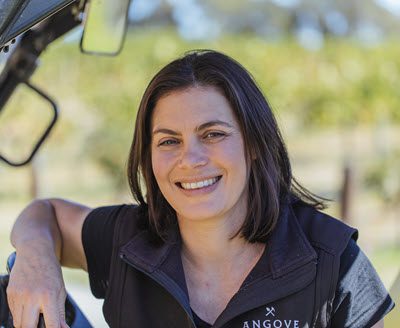Tell us in a few sentences about your experience as a viticulturist, how did you arrive here? My family have a long history in the wine industry, with my great grandfather establishing Angove Family Winemakers in 1886. I am new to the viticultural community, with only a few years working in my family’s vineyards. Prior to working in viticulture, I worked as a teacher and then studied environmental science. It is the combination of viticulture and nature’s ecosystem services that really excites me.
Why did you decide to apply to be an EcoGrower, was there something specific that influenced your decision and/or had you attended a previous EcoVineyards session? As an organic grape grower, we are always looking for natural ways to manage our pest and disease effectively. Having expert help to develop and implement projects that test different biodiversity approaches to pest and disease management is invaluable and can help dictate what we do at a larger scale, as well as hopefully encouraging other growers to employ methods that have been shown to be successful.
Can you provide a brief overview of your project ideas, and what you wish to achieve over the 3 years and why is this important to you? At our Nanya Vineyard one of our biggest management issues are weeds. This project aims to look at a range of native species, including saltbush and native grasses, as potential weed suppressants. Importantly, implementation of these species in the vineyard needs to be able to be achieved at a large scale, both financially effectively and in terms of management. We are also hoping to remediate an area of our vineyard that is salt affected and often waterlogged by planting water and salt loving plants in rows to help reduce ground water movement into the area.
Are you just starting to learn, or have you been enhancing biodiversity on your property and is this an extension of what you are currently doing? We have been trialling a range of biodiversity approaches to complement our vineyard management for a while. Approaches range from slashing every second row to maintain natural pest predator habitat to rehabilitating nature corridors with insectary plants. Prior to being organic we had success with saltbush and native grasses in the midrow, however an unfortunate spray event wiped them out. We are hoping that the EcoVineyards Program can help us return natives to the vineyard.
Where do you see grape growing in the future, do you feel there is an urgency to change current practices? If so, why? I hope in the future there is continued movement away from monocultural viticultural practices to vineyards that are managed as ecosystems, incorporating biodiversity assets in and around the vineyard in order to utilise nature’s resources to manage pest and disease. By adopting sustainable farming techniques and improving vineyard health from the soil up, we will be able to safeguard the industry and preserve regional biodiversity into the future.
What else would you like to share with the broader EcoVineyards community, what gets you excited about the future? I am excited to start revegetating our own vineyards with pre-European vegetation to help restore and hopefully conserve regional biodiversity. By doing this we can start to use ecosystem services, provided by functional biodiversity, to help manage our pest and disease, improve soil moisture retention, reduce erosion, and increase nutrient cycling. All these services can reduce costs at the same time as increasing yield and quality.

